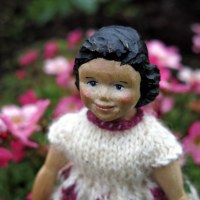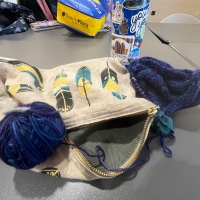The Milliner’s Secret
Having just read about the couturiers and milliners of WWII Paris, I was excited to find a novel set in that era. I was hoping that maybe more information about Théâtre de la Mode would be included in The Milliner’s Secret, by Natalie Meg Evans.
As it happened, that exhibition is not mentioned in the book, but its main character, Coralie, is a personification of the resourcefulness and tenacity that the creators of the Théâtre evidenced.
In 1937, London factory worker Cora Masson takes a chance to visit Paris with an attractive German gentleman she met at a racetrack. After an interlude as a pampered mistress, she finds herself on her own, and with no reason to return to London, reinvents herself as milliner Coralie de Lirac. Then, as the Occupation sweeps across France, she must draw on her working class skills to survive and keep her spirit alive.
Embed from Getty ImagesOver the last 10 days I have had a very bad cold, and this book was the perfect companion to help me get through it. The plot twists and turns made me forget all about sniffling and coughing. I read a lot and can usually predict the plot, but with this book, there were many times I finished a chapter thinking, “I did not see that coming!”
A recurring theme in both books was the way Parisian women used fashion to show defiance against the invaders. Here is the non-fiction Théâtre de la Mode:
Embed from Getty ImagesHow did the Parisienne fare in her struggle against deprivation, gloom, and hardship? We see her on her way through the streets of Paris on her bicycle, sporting a tailored suit with slightly outsized shoulders; a short skirt, naturally, for fabrics were scarce; her legs painted; platform shoes; the shoulder bag carefully not worn the same way as the mailman’s; and hats so fanciful and extravagant they bordered on the irreverent. Much prose had been devoted to those hats….In his memoirs, Christian Dior also mentioned those incredible hats: ‘Made of scraps that could not be used for anything else, they looked like huge pouffes that defied both the period’s woes and common sense.’
Such sartorial insouciance came as a shock to the women serving in the English and American armies that came to liberate Paris, yet it had served as a weapon against the austerity inflicted by the Germans,who had become so impatient with the general display of insolence that by 1944 they had threatened to close down every single milliner’s shop.
–Nadine Gasc, Haute Couture and Fashion 1939-1946, in Théâtre de la Mode
And here is Natalie Meg Evans in The Milliner’s Secret:
Embed from Getty ImagesIt wasn’t so much a fresh mood sweeping Paris as the days lengthened — people were still hungry, angry, and frightened — as a new game, called Bait the Occupiers. Make fools of them but never let them know it. It was a very feminine game…
It boiled down to shape and proportions. The couture collections at the end of February took the previous year’s silhouette to a new extreme and, as ever, hats reflected the trend. Coralie came up with voluminous shapes to balance bold shoulders, narrow waists and puffed skirts. The new style suited chic Frenchwomen, but not broad German frames.
[Coralie is creating a hat for a German customer –] Taking a handful of stiff ribbon from a basket, she added bows and loops, which quadrupled the hat’s dimensions. Red and white, barber-shop colours…. the result was a hair’s breadth away from absurd. teamed with the woman’s outfit, a red and white striped suit from Jacque Faths’s latest collection…
Showing Frau Pfendt how to hold the hat together on her head, Coralie perched on the sofa arm and invited her to walk up and down. She called out, “Brava,” while reflecting that short A-line skirts gave no quarter to stocky legs. Nor had Monsieur Fath designed the blouson jacket for matronly bosoms. Add grey pigskin ankle boots … ‘over-dressed teapot.’
Natalie Meg Evans, The Milliner’s Secret, Chapter 29
Besides the unpredictable plot and the fashion tidbits, another thing I enjoyed about this book was the sharply drawn characters. I had no trouble (even in my cold-remedy-induced fog) keeping the characters straight. And all of the main characters, whether British, French, or German, had both good and bad qualities — you were never sure if a character’s words and deeds could be trusted, or would lead to betrayal down the line.
Embed from Getty ImagesThe thing I appreciate most about the book is the portrayal of Coralie’s inner turmoil. She is not a character from 2016 dropped into 1940, knowing immediately what side she is on and that her cause is just. She has no idea what is happening around her. With extremely limited information, experience, and time, Coralie has to choose which actions will help her survive. Often she is short-sighted about the repercussions others will face, but often, none of the outcomes will be good. She draws on her own resources and does what she thinks she has to.
Embed from Getty ImagesOne thing I did wish for in this book was more information from the author about what motivated her to write this particular story, whether it was based on a real-life person or not, and about what sources she used.
I recommend this book for those times when you want a long novel that will give you a break from today’s world, but still give you lots to think about.
















Thank you, that is indeed very interesting and a friend has the Theatre de la mode book from Maryhill and is loaning it to me tomorrow!! JOY Hope you are feeling better!!
I hope it is the second edition from 2002 because I believe they added a lot of info and pictures. But even if it is the first edition, I think you will love it!
I am not totally back up to speed but I am feeling much better, thank you!
I too hope your cold improves soon. Our libraries unfortunately have nothing by this author. 😦 I find it impossible to buy everything interesting that I hear of.
Yes, she is a new author with only three books out, so I can see why they don’t have it. I don’t know if you use an e-reader but the book was $2.99 on Kindle, and then I do the Kindle Unlimited where I pay $10 a month and can borrow 10 books at a time, so I read it with that. But there is only so much time and too many books to choose from!
I saw on your upcoming reading list that you are going to read Pilgrim at Tinker Creek — I loved that book! I think it was the first book I ever read in the genre of nature essay and it was eye-opening for me.
This is a useful review. It tells me not just that you liked the book but enough about *why* you liked it so I can see that I might, too. I’ll check the library! (Hope you’re back to feeling normal!)
Yes, I think it is so much easier to tell why you didn’t like a book than to put your finger on what it was that made you like a book! I think as I get older and read so many books, it gets harder for an author to surprise me, and I am very happy when they manage it! 🙂
Sounds like a good novel for a bad cold. Hope you are now feeling better!
I am feeling better, but not fully up to par. Maybe another good novel will cure me! 🙂
Sorry for the cold, but glad you had some good company. Your review got me thinking about milliners and the demise of hat shops. Bill Cunningham, who just died, started as a hat maker. Really, a hat with attitude can just make an outfit. Love those platform heels in your pix.
I did not know Bill Cunningham had died! I love that documentary about him, that was the first place I ever heard of him, not being a big reader of the New York Times.
It amazed me in the book how everyone stuck to the hat habit, even in the midst of all the shortages. And then to have them just succumb to fashion 20 years later. Although I guess it makes sense, since we take cars or trains or buses instead of walking places — we have to squeeze in and not drip on anyone. But I am sorry they went.
Summer colds are the pits but so glad you had a good book to help you get through. Sounds like a very interesting book but I know our small library will not have it. Hope you are feeling better soon.
Pingback: Basting, Bingeing, and Books | Deep in the Heart of Textiles
Pingback: TextileTopia | Deep in the Heart of Textiles